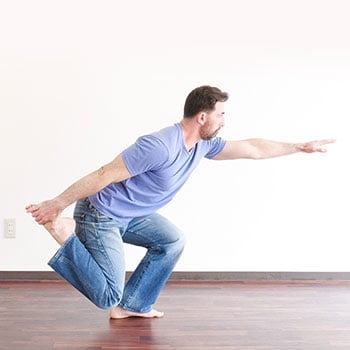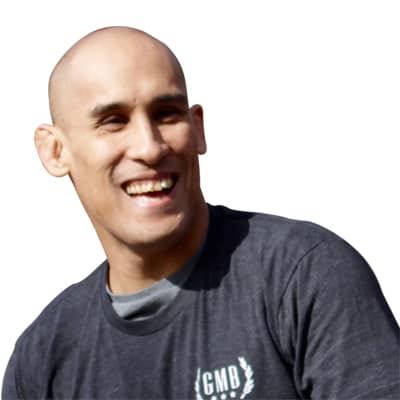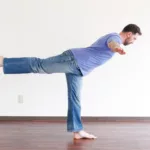Here’s a loaded question:
Are you exercising just to get stronger in the gym, or are you doing this to help you move and feel better in “the real world”?
If you’re here, it’s safe to assume you’re interested in the latter!
That’s really been at the heart of what we’ve been teaching and spreading the word about, that your workouts shouldn’t be about chasing numbers – using ever more and more weight even if it makes you feel crappy and adding more reps just so you feel exhausted – but instead should be fundamentally improving your quality of life outside the gym.
Along with improving your physical performance for sports and other activities, you should also be truly enriching your daily movements. Training that provides you with the strength, balance, and adaptability necessary for life’s myriad challenges.
And single-leg exercise training is definitely a category that will help you do that, fostering practical and immediately usable strength, balance, and adaptability.
Beyond Balance: How Unilateral Leg Training Changes the Game
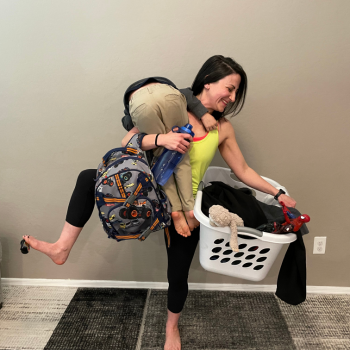 Single-leg exercises are the unsung heroes of functional fitness.
Single-leg exercises are the unsung heroes of functional fitness.
They’re not just about showing off; they’re a means to unlock practical, immediately applicable strength and stability, cultivating the kind of strength, balance, and coordination that you use every day. Whether you’re climbing stairs, picking up your child, or navigating uneven terrain during a hike, you’re relying on the capabilities that single-leg training enhances.
It’s fitness rooted in reality, preparing you for the movements and challenges you face outside of the gym walls.
There’s literally dozens of single leg exercises you can do, and we’ve shared a ton of options before. But rather than just listing out 36 different ones and making you even more confused, let’s dive into just a handful that have given our clients real, tangible benefits.
Single-Leg Squat Variations: Shrimps and Pistols
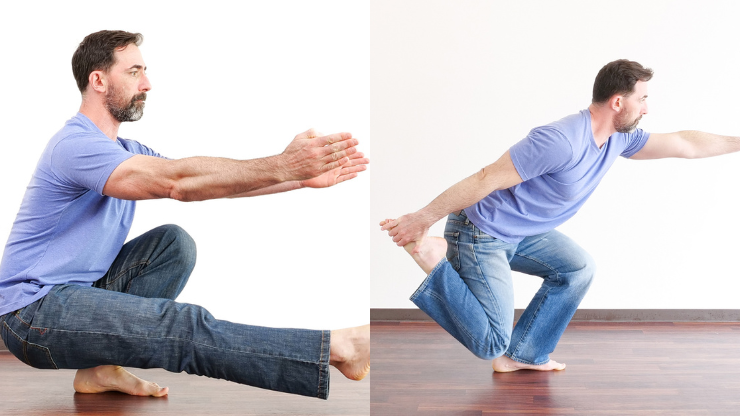 Let’s start with the Shrimp Squat and the Pistol Squat.
Let’s start with the Shrimp Squat and the Pistol Squat.
These two form a core part of our approach to leg strength training. These exercises are great demonstrations of your lower body capability, but it’s worth emphasizing that we see these not as ultimate goals but as tools to help you build strength, mobility, and overall physical capability.
They can be very difficult when you first start practicing them, and can even be so frustrating that people give up, but just as with anything that’s hard but will ultimately help you, the key is persistence. It’s not just about mastering these squats; it’s about the journey of improving your strength and fitness, and the benefits that journey brings to your everyday life.
Here’s Eduardo with some great tips for how to approach practicing pistols and shrimp squats that will take a bit of the frustration away and help you gain as much as you can from whatever level you are at right now.
Master the Pistol Squat
View this post on Instagram
Pistol Squat Form Tips
- Train the “Bottoms-Up” method, a unique progression strategy that deviates from the norm. This approach not only helps you achieve the pistol squat but also enhances the benefits you derive from practicing this skill.
- Contrary to what you might think, the real challenge in pistol squats isn’t the ascent, but learning the proper weight shifting in the transition point. Practicing from the bottom up, helps you get this quicker!
- Full Tutorial: The Unorthodox Pistol Squat Progression
Shrimp Squat Cocktail
(For some reason ☝️ that makes me giggle…)
View this post on Instagram
Form Tips for the Shrimp Squat
- We’ve found that the Shrimp Squat is the best single leg exercise for beginners, as there are many ways to adapt it to any skill level right away.
- Also, don’t worry about the old, and frankly bad advice of not letting your knee go past your toes. It’s outdated and wrong. As long as you progress with control and mindfulness it’s not only fine but can be a great thing for the health of your knees.
- Shrimp vs Pistol: Get Better Hips and Knees with the Shrimp Squat
Don’t Obsess Over Imaginary Achievements
Setting goals is great, but…
We can’t say it enough, please don’t be in such a hurry to achieve “the perfect pistol/shrimp.” It’s definitely not a race and no one I know of is handing out medals for them!
And you may even be able to do a couple reps of them right now, but the real value lies in the consistent practice and gradual progression tailored to your current abilities. This approach ensures you’re not just going through the motions but are truly engaging with and benefiting from each exercise.
Immerse yourself in a process that challenges and strengthens you at every stage, bringing about the most substantial and sustainable gains over time.
The Subtle Power of Scales: Stability, Strength, Control
Now let’s shift our focus to the often overlooked rare gems of single-leg exercises: the Scales.
 At first glance, these movements might not strike you as powerhouses of strength development. But, don’t let their subtlety fool you. Once you give them a real go, you’re in for a revelation.
At first glance, these movements might not strike you as powerhouses of strength development. But, don’t let their subtlety fool you. Once you give them a real go, you’re in for a revelation.
These exercises, though they may seem simple, are profound tools for enhancing everything from hip stability to foot strength.
The beauty of the Scales lies in their deceptive simplicity.
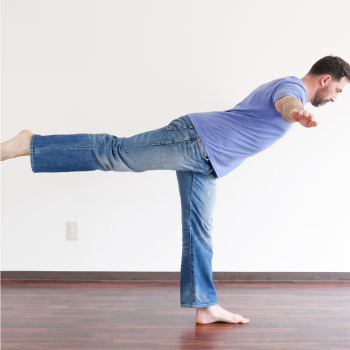 They require you to engage muscles you didn’t even know played a role in your balance and stability. As you practice, you’ll find these exercises challenging your body in new ways, highlighting areas that may have been neglected in more traditional training routines.
They require you to engage muscles you didn’t even know played a role in your balance and stability. As you practice, you’ll find these exercises challenging your body in new ways, highlighting areas that may have been neglected in more traditional training routines.
And that’s really the essence of what single leg training is all about. Every movement where you are challenged to be mostly on one leg, no matter how straightforward it appears, can contribute significantly to your overall strength and balance.
So, when you extend that leg and hold the Scale, remember: it’s not just an exercise; it’s a commitment to holistic improvement, from your hips down to your toes.
Practice Your Scales
View this post on Instagram
Form Tips for the Scales
- Learning how to do the Front Scale and Back Scale will give you a lot of insights into your flexibility, strength, and balance.
- It’s normal to think that standing on one leg is all about balance. But balance is more than just one thing. Balance is the integration of the strength from your hip to your toes, body and spatial awareness, and your comfort in your active mobility. All of this can be trained and improved!
- Full Tutorial: The Surprising Effectiveness of Scales
Peacock Squats: Where Power Meets Agility
Another great aspect of single leg training is the ability to change directions and angles.
Life makes you do lots of twists and turns, and there’s no benefit for making your training exclusively linear. While being strong in a straight up-and-down motion is valuable, real-world scenarios often require us to adapt our movements on the fly.
That’s where the true beauty of single-leg exercises shines, particularly through the dynamic nature of the Peacock Squat.
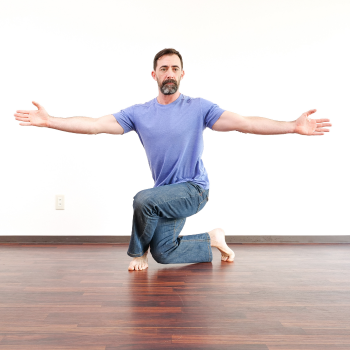 This nuanced exercise significantly enhances your hip rotation control, an essential skill often overlooked in standard training routines. Whether you’re on a sports field making rapid directional changes in a soccer match or basketball game, or at home maneuvering awkward spaces during cleaning or rearranging, your body is frequently asked to move beyond the straight and narrow.
This nuanced exercise significantly enhances your hip rotation control, an essential skill often overlooked in standard training routines. Whether you’re on a sports field making rapid directional changes in a soccer match or basketball game, or at home maneuvering awkward spaces during cleaning or rearranging, your body is frequently asked to move beyond the straight and narrow.
The Peacock Squat isn’t just another item in your workout checklist; it’s a practical approach to holistic fitness.
It prepares you for the unpredictable nature of daily activities, ensuring you’re as agile and adaptable as you are strong. So, when you incorporate Peacock Squats into your routine, you’re not just fostering muscle growth; you’re equipping your body with the multidirectional strength and versatility needed for life’s many twists and turns.
Practicing Peacock Squats
View this post on Instagram
Form Tips for the Peacock Squat
- The addition of a simple directional change with one leg creates a big benefit in the Peacock Squat. Don’t worry so much about how far you move the leg to the side, or even how low you go. Focus on the how the movement affects your hip position and notice what you’re feeling.
- Glute work isn’t just extending and hinging, the gluteals also work in rotation. Bringing your leg to the side like you do in these squats automatically makes the other hip work hard to counter that rotational force. So don’t be surprised if you feel this in your booty!
No More Waiting: The Time to Enrich Your Movement Is Now
It’s normal to want to “perfect” and get better at one move before you try mixing things up.
And while we are big fans of continually practicing “the basics”, that doesn’t mean just hammering three singular exercises over and over and never trying anything else!
Embracing variety and integration in your routine doesn’t just keep things interesting; it’s a key part of continued growth and progress. So, while you should cherish the basics, don’t shy away from weaving in new patterns and challenges.
Effective training mirrors the unpredictability and fluidity of everyday life.
It’s not just about mastering individual exercises but understanding how they can blend and complement one another. Life usually doesn’t require you to use fully isolated muscles and movements; it asks for adaptability and the ability to transition smoothly from one challenge to the next.
View this post on Instagram
While there’s value in striving for excellence in specific exercises like the pistol squat or shrimp squat, it’s equally important to recognize the benefits of versatility in your training regimen. You don’t need to wait until you’ve perfected one exercise to start experimenting with others.
This approach is about building practical strength and agility that serve you not just in the gym but in real-life scenarios.
It encourages a focus on functional adaptability over isolated proficiency. So, even if you’re still working on perfecting your pistol squat, don’t hesitate to combine it with a scale and shrimp and a peacock or two.
 It’s the combination and interaction of these exercises that will help you develop the kind of fitness that is practical, dynamic, and responsive to life’s demands.
It’s the combination and interaction of these exercises that will help you develop the kind of fitness that is practical, dynamic, and responsive to life’s demands.
In essence, fitness is more nuanced than just mastering individual exercises. It’s about creating a synergy between different forms of movement, fostering a body that’s prepared for the diverse challenges life throws your way.
So, embrace the variety and start exploring how different exercises can work together to build a more adaptable, ready-for-anything version of you.
Get Kick-Ass Strong, One Leg at a Time
Integral Strength is a skill-based strength program that includes single leg strength as well as upper body holisitic exercises to help you build practical skills and strength that carry over into the rest of your life.


